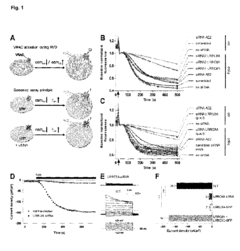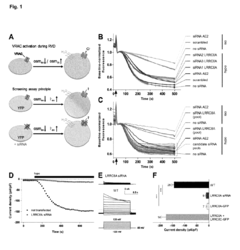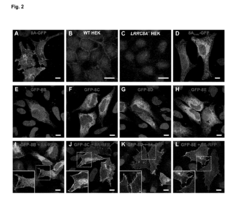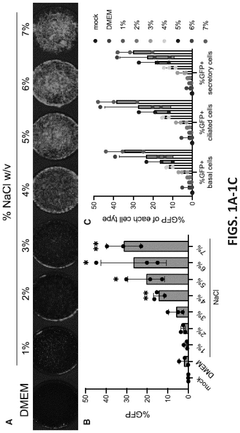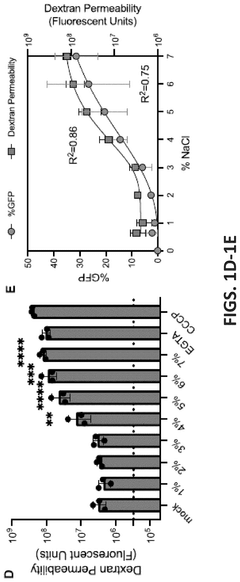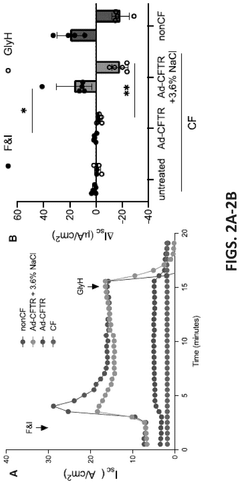How to Understand Hypertonic Solutions in Genomic Research?
Hypertonic Solutions in Genomics: Background and Objectives
Hypertonic solutions have played a crucial role in genomic research, revolutionizing various aspects of molecular biology and genetic studies. These solutions, characterized by their higher solute concentration compared to the surrounding environment, have become indispensable tools in numerous genomic applications. The evolution of hypertonic solutions in genomics can be traced back to the early days of DNA isolation and purification techniques.
The primary objective of utilizing hypertonic solutions in genomic research is to manipulate cellular osmotic pressure, facilitating the extraction, isolation, and preservation of genetic material. By creating an environment with higher solute concentration outside the cell, these solutions induce osmotic stress, leading to cell shrinkage and membrane permeabilization. This process is fundamental in various genomic techniques, including DNA extraction, cell lysis, and protein isolation.
Over the years, the applications of hypertonic solutions in genomics have expanded significantly. They are now integral to advanced techniques such as polymerase chain reaction (PCR), DNA sequencing, and gene therapy. The ability of hypertonic solutions to stabilize nucleic acids and proteins has made them invaluable in long-term storage of genetic samples, ensuring the integrity of genomic material for future analysis.
The development of hypertonic solutions has been closely tied to the progress in genomic research methodologies. As our understanding of cellular processes and genetic mechanisms has deepened, so too has the sophistication of hypertonic solution formulations. Modern solutions are carefully designed to optimize specific genomic applications, balancing factors such as osmolarity, pH, and ionic composition to achieve desired results while minimizing damage to genetic material.
Looking ahead, the role of hypertonic solutions in genomic research is expected to continue evolving. Emerging fields such as single-cell genomics and epigenetics present new challenges and opportunities for the application of these solutions. Researchers are exploring novel formulations that can enhance the efficiency of DNA extraction from challenging samples or improve the preservation of epigenetic markers during cell processing.
Understanding hypertonic solutions in genomic research requires a multidisciplinary approach, combining principles from molecular biology, biochemistry, and biophysics. This comprehensive understanding is crucial for developing innovative techniques and pushing the boundaries of genomic research. As we delve deeper into the complexities of the genome, the strategic use of hypertonic solutions will remain a cornerstone in unlocking the secrets of genetic information and advancing our knowledge of life at its most fundamental level.
Market Demand for Hypertonic Solutions in Genomic Research
The market demand for hypertonic solutions in genomic research has been steadily increasing in recent years, driven by the rapid advancements in genetic sequencing technologies and the growing emphasis on precision medicine. Hypertonic solutions play a crucial role in various genomic research applications, including DNA extraction, cell lysis, and sample preparation for sequencing.
One of the primary factors fueling the market demand is the expanding field of personalized medicine. As healthcare providers and researchers strive to develop tailored treatment strategies based on individual genetic profiles, the need for high-quality genomic samples has surged. Hypertonic solutions are essential in maintaining the integrity of these samples during processing and analysis, thereby contributing to more accurate and reliable results.
The pharmaceutical industry has also emerged as a significant driver of demand for hypertonic solutions in genomic research. Drug discovery and development processes increasingly rely on genomic data to identify potential targets and assess drug efficacy. This trend has led to a growing need for efficient and reliable sample preparation methods, where hypertonic solutions play a vital role.
Academic research institutions and biotechnology companies are other key contributors to the market demand. As these organizations intensify their efforts in areas such as cancer genomics, rare disease research, and population genetics, the requirement for specialized reagents and solutions, including hypertonic solutions, continues to rise.
The global market for genomics is projected to experience substantial growth in the coming years, with some estimates suggesting a compound annual growth rate (CAGR) of over 15% through 2025. This growth is expected to directly impact the demand for hypertonic solutions and other related reagents used in genomic research.
Geographically, North America currently leads the market for hypertonic solutions in genomic research, followed by Europe and Asia-Pacific. However, emerging markets in Asia, particularly China and India, are expected to witness rapid growth due to increasing investments in genomic research infrastructure and rising awareness of personalized medicine.
The COVID-19 pandemic has further accelerated the demand for genomic research tools, including hypertonic solutions, as researchers worldwide focus on understanding the virus's genetic makeup and developing targeted therapies and vaccines. This unexpected boost has created new opportunities for market expansion and innovation in the field of hypertonic solutions for genomic applications.
Current Challenges in Hypertonic Solution Applications
Despite the widespread use of hypertonic solutions in genomic research, several challenges persist in their application. One of the primary issues is the difficulty in maintaining consistent osmolarity across different batches of solutions. This variability can lead to inconsistent results in experiments, particularly when working with sensitive cellular systems or delicate genomic material.
Another significant challenge is the potential for cellular damage or stress responses induced by hypertonic conditions. While hypertonic solutions are often used to manipulate cell volume or induce plasmolysis, prolonged exposure can lead to unintended consequences such as changes in gene expression, protein folding, or cellular metabolism. These effects can confound experimental results and complicate data interpretation in genomic studies.
The interaction between hypertonic solutions and various biomolecules presents another hurdle. Different solutes used to create hypertonic conditions may have varying effects on DNA, RNA, and proteins. For instance, some hypertonic solutions may alter the secondary structure of nucleic acids or affect protein-DNA interactions, potentially impacting downstream applications such as PCR or sequencing.
Researchers also face difficulties in optimizing hypertonic solution compositions for specific genomic applications. The ideal concentration and type of solute can vary significantly depending on the cell type, tissue, or organism being studied. This necessitates extensive optimization processes, which can be time-consuming and resource-intensive.
The scalability of hypertonic solution applications in high-throughput genomic research poses another challenge. Ensuring uniform exposure and consistent effects across large numbers of samples or in automated systems can be problematic, potentially introducing bias or variability in large-scale genomic studies.
Furthermore, the long-term effects of hypertonic treatments on genomic stability and integrity remain a concern. While short-term exposures are generally well-tolerated, the cumulative impact of repeated or prolonged hypertonic stress on genomic material is not fully understood, particularly in the context of multi-generational studies or long-term cell culture experiments.
Lastly, the development of standardized protocols for the use of hypertonic solutions in genomic research remains an ongoing challenge. The lack of universally accepted guidelines for solution preparation, application methods, and quality control measures can lead to discrepancies between different research groups and hinder the reproducibility of genomic studies involving hypertonic treatments.
Existing Hypertonic Solution Formulations and Protocols
01 Medical applications of hypertonic solutions
Hypertonic solutions are used in various medical applications, including treatment of edema, intracranial pressure reduction, and as a component in wound healing therapies. These solutions can help draw excess fluid from tissues and promote osmotic balance in the body.- Medical applications of hypertonic solutions: Hypertonic solutions are used in various medical applications, including treatment of edema, intracranial pressure reduction, and as a component in wound healing therapies. These solutions can help draw excess fluid from tissues and promote osmotic balance in the body.
- Formulation of hypertonic solutions for specific treatments: Hypertonic solutions are formulated with specific concentrations and compositions for targeted treatments. These may include saline solutions, sugar-based solutions, or combinations of electrolytes and other active ingredients tailored for particular medical conditions or therapeutic purposes.
- Use of hypertonic solutions in cell culture and preservation: Hypertonic solutions play a crucial role in cell culture techniques and preservation of biological samples. They are used to maintain osmotic balance, control cell volume, and protect cells during cryopreservation processes.
- Hypertonic solutions in ophthalmic applications: Hypertonic solutions are utilized in various ophthalmic treatments, including management of corneal edema, dry eye syndrome, and as a component in eye drops. These solutions help maintain proper osmolarity in the eye and can alleviate certain ocular conditions.
- Development of novel hypertonic solution delivery systems: Innovative delivery systems for hypertonic solutions are being developed to enhance their efficacy and ease of administration. These may include controlled-release formulations, specialized applicators, or combination with other therapeutic agents for synergistic effects.
02 Formulation of hypertonic solutions for specific treatments
Hypertonic solutions are formulated with specific concentrations and compositions for targeted treatments. These may include saline solutions, sugar-based solutions, or combinations of electrolytes and other active ingredients tailored for particular medical conditions or therapeutic purposes.Expand Specific Solutions03 Use of hypertonic solutions in cell culture and preservation
Hypertonic solutions play a crucial role in cell culture techniques and preservation of biological samples. They are used to maintain osmotic balance, prevent cell lysis, and optimize conditions for cell growth and storage in laboratory settings.Expand Specific Solutions04 Hypertonic solutions in ophthalmic applications
Hypertonic solutions are utilized in various ophthalmic treatments, including management of corneal edema, dry eye syndrome, and as a component in eye drops. These solutions help maintain proper osmolarity and hydration of ocular tissues.Expand Specific Solutions05 Development of novel hypertonic solution delivery systems
Innovative delivery systems for hypertonic solutions are being developed to enhance their efficacy and ease of administration. These may include specialized devices, controlled release mechanisms, or combination with other therapeutic agents to improve treatment outcomes.Expand Specific Solutions
Key Players in Hypertonic Solution Development
The field of hypertonic solutions in genomic research is in a mature stage, with established applications in DNA extraction and purification. The market size is substantial, driven by the growing demand for genomic analysis in various sectors. Technologically, the field is well-developed, with companies like Agilent Technologies, Inc. and Roche Diagnostics Operations, Inc. offering advanced solutions. Academic institutions such as Massachusetts Institute of Technology and Harvard College contribute significantly to research advancements. The competitive landscape is diverse, featuring both industry leaders and specialized research centers like Dana-Farber Cancer Institute, indicating a balanced ecosystem of innovation and commercial application.
Agilent Technologies, Inc.
Massachusetts Institute of Technology
Innovative Approaches in Hypertonic Solution Research
- The use of LRRC8 proteins and their complexes, specifically LRRC8A, LRRC8B, LRRC8C, LRRC8D, and LRRC8E, to develop methods for identifying VRAC modulators, including agonists and antagonists, by interacting with candidate substances and determining their effects on ion and organic osmolyte transport across cellular membranes.
- The use of a hypertonic solution, specifically a hypertonic salt solution with a salt concentration ranging from about 1% to 8%, is introduced to enhance the delivery of gene therapy vectors by contacting cells with it before, after, or simultaneously with the vectors, thereby improving gene transfer efficiency.
Regulatory Considerations for Hypertonic Solutions in Research
The regulatory landscape for hypertonic solutions in genomic research is complex and multifaceted, requiring careful consideration of various guidelines and standards. Researchers must navigate a web of regulations that govern the use, storage, and disposal of these solutions, as well as the safety protocols for handling them in laboratory settings.
One of the primary regulatory bodies overseeing the use of hypertonic solutions in research is the Food and Drug Administration (FDA). The FDA provides guidelines on the quality control and manufacturing practices for solutions used in genomic research, ensuring that they meet stringent safety and efficacy standards. These regulations are particularly important when hypertonic solutions are used in the development of gene therapies or other advanced genomic applications.
The Environmental Protection Agency (EPA) also plays a crucial role in regulating the disposal of hypertonic solutions used in genomic research. Proper disposal methods must be employed to prevent environmental contamination and ensure compliance with hazardous waste regulations. Researchers must be well-versed in these disposal protocols to maintain regulatory compliance.
Institutional Review Boards (IRBs) are another key component of the regulatory framework. They are responsible for reviewing and approving research protocols involving hypertonic solutions, particularly when human subjects are involved. IRBs ensure that the use of these solutions in genomic research adheres to ethical standards and protects the rights and welfare of research participants.
Biosafety regulations are also critical when working with hypertonic solutions in genomic research. The Centers for Disease Control and Prevention (CDC) and the National Institutes of Health (NIH) provide guidelines on biosafety levels and practices that must be followed when handling potentially hazardous materials, including certain hypertonic solutions used in genomic studies.
International regulations must also be considered, especially for collaborative research projects or when conducting studies across borders. The International Conference on Harmonisation (ICH) provides guidelines that aim to harmonize regulatory requirements for pharmaceutical development, including the use of hypertonic solutions in genomic research.
Researchers must also be aware of specific regulations related to the transportation of hypertonic solutions. The Department of Transportation (DOT) has strict guidelines on the packaging, labeling, and shipping of potentially hazardous materials, which may apply to certain hypertonic solutions used in genomic research.
Compliance with these regulatory considerations is essential for ensuring the validity and reproducibility of genomic research involving hypertonic solutions. Researchers must stay informed about updates to these regulations and implement robust quality management systems to maintain compliance throughout their studies.
Ethical Implications of Hypertonic Solution Use in Genomics
The use of hypertonic solutions in genomic research raises several ethical considerations that warrant careful examination. One primary concern is the potential for unintended cellular damage or alterations to genetic material during experiments. While hypertonic solutions are valuable tools for isolating DNA and studying cellular processes, their application may lead to osmotic stress, which could compromise the integrity of genetic samples or introduce artifacts in research results.
Privacy and consent issues also come to the forefront when considering the ethical implications of hypertonic solution use in genomics. As these techniques are often employed in the extraction and analysis of genetic material, there is a need to ensure that proper informed consent procedures are in place, particularly when working with human samples. Researchers must be transparent about the methods used and potential risks associated with hypertonic solution applications.
The long-term effects of hypertonic solution exposure on genetic material are not fully understood, which raises questions about the reliability and reproducibility of genomic research findings. This uncertainty could have far-reaching consequences, especially if research outcomes inform medical decisions or policy-making. It is crucial for the scientific community to address these concerns through rigorous validation studies and the development of standardized protocols.
Another ethical consideration is the potential for misuse or misinterpretation of genomic data obtained through hypertonic solution-based techniques. As these methods become more sophisticated and widely used, there is a risk that genetic information could be used for discriminatory purposes or to make unfounded predictions about an individual's health or capabilities. Safeguards must be put in place to protect against such misuse and ensure that genomic research serves the greater good of society.
The environmental impact of hypertonic solution disposal is an often-overlooked ethical concern. Many of these solutions contain chemicals that may be harmful to ecosystems if not properly managed. Researchers have a responsibility to consider the environmental footprint of their work and implement sustainable practices in the use and disposal of hypertonic solutions.
Lastly, the equitable access to hypertonic solution-based genomic technologies is an important ethical consideration. As these techniques become more advanced and potentially crucial for certain types of research or medical applications, there is a risk of creating or exacerbating disparities in scientific knowledge and healthcare outcomes. Efforts should be made to ensure that the benefits of genomic research using hypertonic solutions are accessible to diverse populations and not limited to well-funded institutions or economically advantaged regions.
